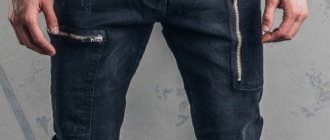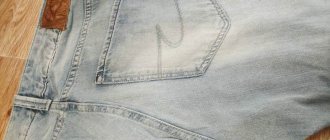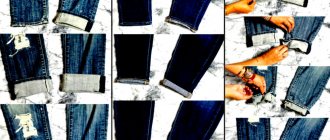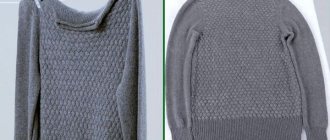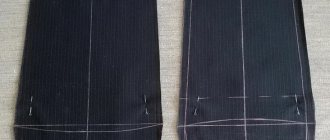For many, jeans are a wardrobe staple. However, regardless of their cost, they wear out over time. The most vulnerable place for a tear to appear is the space between the legs. But you don’t have to throw away your favorite jeans right away; you can increase their lifespan by using a special hidden seam technique and sewing them by hand.
Why do my jeans rub between my legs?
There are several reasons for the appearance of scuffs and holes in jeans between the legs:
- Body shapes. Excessive volume in the hip area, which appears due to heavy weight or increased muscle mass, leads to strong tension in the tissue during wear. In addition, with voluminous thighs, the gap between the inner thighs usually disappears, which leads to pant legs rubbing against each other along the entire length of the thigh.
- Way of walking. A gait in which the legs touch each other on the inside. In this case, the fabric can be rubbed both in the crotch and in the knees.
- Textile. The thicker the fabric, the less one is exposed to external loads. Artificial threads of elastane or polyester make the material stronger. While jeans made from thin denim will not have a long service life, especially if there are other reasons that contribute to the wear of the trousers.
The reasons for jeans rubbing between your legs can be different - from excess weight to poor fabric
- Sedentary work. Sitting still for hours is difficult, so the average person fidgets in his chair from time to time, shortening the life of his jeans.
- Errors when washing. Denim should not be washed in very hot water. Recommendations given by the manufacturer and on the label should be taken into account. If there is no such information, then the water temperature should not be higher than 45°C.
You also need to make sure that when drying, the pant legs are turned inside out and are not exposed to direct sunlight.
Method 1. Sew up the hole with a hidden seam
Below in the picture you can see how to sew two edges, and then by pulling the end thread the seam will hide inside and that’s all.
This method can also be used to sew in larger clothes.
What to do to prevent jeans from rubbing between your legs
In order for jeans to last a long time, even at the purchase stage you should be guided by certain selection rules:
- Tight models wear out faster. Therefore, it is better to opt for more spacious pants.
- Jeans with a high waist or a standard height are more wearable. This is due to their better fit to the body and uniform distribution of load on the fabric. Conversely, models with a low waist will rub in the crotch faster.
- For sedentary work, it is recommended to choose thick denim trousers. And also knowing about the problem of abrasion, you should control your own movements as much as possible. For example, do not “ride” your heel on the chair, but stand up if you need to reach something or bend over.
- It is advisable not to let jeans appear until holes appear. As soon as abrasions and thinning of the fabric become noticeable, measures should be taken immediately - strengthen the fabric.
The quality of the fabric itself is poor
Not only excess weight or full hips can cause the product to lose its beautiful appearance. Those who own jeans with artificial abrasions may quickly become upset that the product will quickly become unusable. The fact is that such fabric is usually very thin. Therefore, it cannot withstand constant friction, washing, use and wears out many times faster than the dense version. If the fabric is supplemented with polyester or elastin, thanks to which it can stretch somewhat, then the product will last a little longer.
How to repair jeans by hand
To repair jeans, you don’t have to be an experienced seamstress; it’s enough to be able to hold a thread and a needle and use it to make simple seams.
What you need for work
The threads you choose for sewing on denim must have high strength.
Threads from the following manufacturers have proven themselves well:
| Firm | Threads |
| Haman | Saba 50, Saba 35, Saba 30, Rasant 75 |
| Gutermann | H120, H75, H35 |
| Coats | Epic 60, T-80N, T-60 |
| Rain Bow | A 202/120 |
If these items are not available in the store, then the choice should be made in favor of reels with an inscription indicating increased strength. If the threads are cotton, numbers 50-80 are suitable. Synthetic threads – 50-60.
To repair jeans, you should use needles with numbers 11 or 14 and a sharp end. If you do not plan to make a decorative patch, then you need to use denim fabric of the most identical color or any other fabric that matches the shade. Additionally, you will need scissors and pins.
Patch
To make a classic patch, you will need 2 scraps of fabric. The first one will be used as a lining, so it can be any color. The second one, if possible, should be matched to the tone of the jeans, then the patch will be less noticeable. However, it is impossible to completely disguise a patch, so patches are often made, on the contrary, more noticeable.
Stages of work:
- Patches should be cut from both pieces of fabric, the size of which should well cover the area of damage and leave 1 cm for the hem.
It is not necessary to fold the bottom flap if the fabric is not loose. Also, if the selected piece of fabric is very dense, then the hem will add unnecessary volume, which can sometimes even rub the body when worn.
- It is recommended to machine stitch the bottom patch. To do this, the flap should be pinned to the pants, then sewn around the perimeter using a machine. Next, you need to lay stitches in different directions inside this perimeter to better attach the fabric to the jeans.
- You need to fold the edges of the outer patch so that the remaining fabric covers the hole and iron it. Then attach the patch to the jeans using thread or pins.
- You can sew on a patch using any seam, from a hidden seam to hide the threads, to a looped one, which, on the contrary, will make the processed edge more visible.
General sewing tips
If the problem of holes and abrasions in jeans between the legs is constant, then it is recommended to strengthen this area of the pants immediately after purchasing the product and washing it for the first time.
Also, you should not wait until the abrasion turns into a hole or a small hole becomes a big one. Taking preventive measures will increase the service life of jeans.
You should carefully consider the choice of fabric for the lining. For example, thick material or thick denim can subsequently chafe the body, especially if the jeans model is narrow. To make the repair of trousers less noticeable to others, you should take the time to find sewing threads that match the color of the fabric.
Sewing the edges
When the hole is small, has a longitudinal shape and does not have torn edges, it can be sewn up with an “over the edge” seam.
For greater strength, it is recommended to first sew the seam “forward with the needle” along the edge.
Strengthening the hole
Sometimes the hole does not need to be sewn up, but strengthened. Jeans that initially have rips and holes can, over time, increase in size and turn into holes, and the holes can become shaggy and untidy.
To prevent further unraveling of the fabric, as well as to update the jeans, you need to make a patch on the wrong side. To do this, you need to take material from old jeans and make two horizontal cuts, the size of which will correspond to the hole being repaired. Then you need to carefully pull out the vertical threads.
After the desired size is reached, this patch should be cut out, retreating 1 cm from the sides. At the final stage, the cut out patch must be sewn on, placing it on the inside under the hole. Sew on with small stitches using thread to match the denim fabric. You can also sew a lining patch in a contrasting color along the edge of the hole.
Option 4
Another option for a denim “highlight” is a flower, which can be used to discreetly and creatively disguise a small hole, for example, in a pocket.
To work, you will need four toothpicks, a bead and threads of any color. You can use, for example, floss or knitting yarn.
Push the toothpicks through the fabric (two along, two across) so that the hole is in the middle. Insert the thread and needle directly into the hole and pull it out of the fabric in the lower left corner. Remove the thread from the needle because the needle will not be needed for the next step.
Now let's start forming the flower. The protruding ends of the toothpicks are the parts around which we will alternately wrap the thread.
First, loop the thread around the bottom left end. From there, start bringing the thread up and wrap it around the top right end. You now have two petals in the shape of a figure eight. So continue to work with the thread (lower left - upper right) until you are satisfied with the thickness of the petals. After this, place the thread at the bottom not at the bottom left, but at the adjacent (to the left of it) end of the toothpick. From there, guide the thread to the empty end of the toothpick opposite. Make enough figure eights again to create voluminous petals. And again move the working thread one toothpick to the left. Continue this way until you have thread wrapped around all the toothpicks.
Now you need to make the middle of the flower. To do this, thread the needle again. Insert it into the center of the flower and bring it out at the top between the toothpicks. Thread the bead onto the thread and secure it right in the middle of the flower. All you have to do is carefully remove the toothpicks from the fabric.
Darning on a sewing machine
It is usually easier to mend jeans between the legs using a machine than by hand.
Such repairs will also be more durable:
- To repair jeans, you need to properly prepare the area for the patch. It is necessary to cut off all protruding threads. You also need to trim the edges of the hole so that the outline is clearly visible. This will ensure that important areas are not missed when performing the patch.
How to mend jeans between legs using a sewing machine
- Then you need to cut out a piece of denim that matches the color and preferably the thickness. The part should be 1 cm wider than the hole.
- The patch should be secured on the wrong side with pins and sewn on with a few stitches on a machine. It is not recommended to baste the patch by hand, as it will be extremely difficult to remove the basting threads after darning.
- You should darn from the front side, placing the seams as close to each other as possible. Ideal if you can repeat the direction of the denim threads.
- Next, you need to fill the surface with stitches running in a perpendicular direction.
Option 7
An even simpler way, after which damaged jeans will be transformed beyond recognition.
To work, you will need a needle and thread that matches the color of the jeans, as well as a second, unnecessary pair of jeans (they may differ in color).
From old trousers, cut out any pocket that is larger than the hole or stain. Cut without tearing, along with the fabric. All that remains for you is to simply sew an old pocket onto men's jeans by hand so that it completely covers the defect. Designer jeans are ready!
As you can see, even without any sewing skills or a sewing machine, you can easily bring seemingly damaged jeans back to life.
How to install a patch
There are two ways to mend jeans between your legs using a machine.
Classic version
It is easy to close a hole or abrasion by making a regular fabric patch over the damage. The square patch is quick and easy to sew on, which is why it is the most popular.
To make a square patch, you need to cut out a square from the fabric that will cover the hole, leaving 0.5-1 cm for the hem. Then the part should be ironed, bending the edges and secured to the jeans. Experienced craftswomen can use pins for this.
For those who are not confident in using a sewing machine, it is better to baste the patch by hand. Next, the square must be sewn to the jeans, placing the seams around the perimeter of the workpiece.
This method can be difficult if the hole is in a hard-to-reach place. In this case, you can simplify the work if you slightly open the nearest factory seam. After the hole is sewn up, all that remains is to carefully stitch the seam, choosing threads of the desired color.
Recovery
It is possible to mend jeans between the legs using a machine even when the damage is large and the patch option is no longer suitable. To do this, you should use the restoration method, which consists of completely replacing the damaged part of the product. In this case, the replacement should be made symmetrically.
To work you will need:
- pieces of denim of a suitable color,
- threads of 2 colors: to match the jeans and matching the threads used to make the seams on the jeans by the manufacturer.
Stages of work:
- It is necessary to rip out part of the back seam running in the center, as well as the side seams.
- Cut out the frayed section of the pants.
- Next, on the other side of the back seam, cut a piece of fabric identical in shape.
- The cut piece of jeans should be attached to the prepared flaps and symmetrical parts should be cut out.
- Then all the details need to be basted and carefully sewn into the jeans.
To prevent the jeans at the crotch from fraying longer, it is recommended to cut the insert parts so that the guide threads run diagonally. This will allow the fabric to stretch better.
You can also strengthen your jeans if you use thick corduroy or leather rather than denim. To make the insert look natural, you can sew patches from the same fabric in other places on the jeans.
Option 5
Another option is jeans with an incredible number of holes. If you don’t want to throw them away, but wearing them is not very comfortable, then you can slightly modify them.
Take the guipure and cut out pieces slightly larger than the holes. Turn the jeans inside out, attach guipure to them and secure along the edges with tailor's pins - this will make your work easier.
Turn your pants inside out and start sewing. The color of the threads should match the color of the jeans as much as possible, then the seam will be almost invisible. Stepping back about 0.5 cm from the edge, place small stitches along the entire perimeter. For ease of use, place paper or cardboard between the legs. This will help you avoid accidentally sewing two pant legs together. After sewing, carefully trim off the excess guipure.
How to sew up a hole in jeans without a patch
You can mend jeans between your legs either with a machine or with your hands. It all depends on the type of damage and its location.
For example, in some cases there is no need to sew a patch onto the damaged area of the jeans. If the hole is a straight line, or resembles the letter “G”, then it is recommended to darn it manually without using patches.
What you will need:
- A needle of medium length or long.
- Threads matched as closely as possible to the tone of the denim fabric.
Stages of work:
- It is necessary to stitch along the long side of the abrasion. If “native” threads of the fabric remain on the damage, then the thread should be passed alternately under such a thread, then over the next thread.
At the end of the row, the needle should be threaded from the edge through 2-3 threads of the undamaged part of the fabric. When turning to the next edge, you need to maintain a balance - the distance from the edge of the hole should be minimal, but at the same time ensuring good fastening. This will make the darned area less noticeable and will also prevent the fabric from fraying further.
- The threads should be pulled as close to each other as possible. The density of the darning and its durability depend on this.
- Next you need to continue darning along the short side of the hole. The needle should also be passed first under the thread located perpendicularly, then over the next thread. It is important to ensure that the fabric is dense, without gaps.
- With a successful selection of thread color and proper darning, the repaired area will be barely noticeable.
Option 3
If desired, the flaw (hole) can be turned into a “highlight” of the jeans. So, if a small hole appears on your children’s jeans (your beloved child got caught on something while out for a walk), then it can easily be turned into a bright ladybug. No special skills are required from you - just the ability to hold a needle in your hands.
You will need red and black floss threads, a needle and scissors. Draw a circle around the hole using a coin. Immediately divide it into 2 parts - head and abdomen.
Now thread a red thread into the needle and start embroidering the abdomen from the middle with stitches (in stockinette stitch). After this, immediately make a dividing strip with black thread and move to the head. At the end of the work, make antennae and legs using separate stitches. Make black dots on the wings using knots. The ladybug is ready. No one will even guess that she is covering the hole.
Other repair methods
A hole in your jeans is not always a reason to be upset.
If you approach the problem creatively, you can create interesting and fashionable things.
How to hide a hole in jeans, fill it up beautifully, decorate it
There can be many options when the hole is not just sewn up, but also decorated.
How to sew a hole in jeans between the legs
Mending jeans between the legs using a machine may seem like a boring solution to the problem for some. Especially when modern fashion welcomes street style.
To take advantage of the opportunity and add a “zest” to your favorite pants, you can choose a deliberately bright thread for darning or, using traditional darning, perform sashiko stitches or any other embroidery.
How to fix a hole in your knee
You can decorate a torn knee using the Japanese technique of sashiko. Sashiko embroidery consists of simple forward stitches made with contrasting thread that can be worked in any direction.
Stages of work:
- You need to cut a rectangular piece from the desired fabric. This part should be 3 cm larger than the hole.
- Having placed the patch on the inside, you need to baste it. Since the hole is on the knee, the fabric of the patch should not be stretched, otherwise the knee will be difficult to bend.
- To ensure that the rows of sashiko stitches run smoothly, it is recommended to draw the lines with chalk, a piece of soap or a special washable felt-tip pen.
- Stitches should be short on the front and long on the back. In this case, a number of stitches must be made with a needle at once, collecting the fabric into an accordion.
- How many rows to make depends on the imagination of the craftswoman. The main thing is that there are enough of them to secure the patch on the knee.
How to remove a hole in your butt
Holes do not always need to be darned or sewn up using classical methods.
Damage to pants on the butt, hidden behind bright appliqués or embroidery, often looks more interesting and natural.
How to remove a hole in a pocket
Jeans pockets often get worn out. Rear due to friction against outer clothing or chairs. Holes may appear on the front ones when there is a habit of keeping your hands in your pockets or carrying small things in them.
Jeans will look fashionable if you don’t hide the hole, but rather emphasize it. The only thing to keep it from spreading is to secure the edges.
The hole can be given any shape, for example, made in the shape of a heart. Small wear on the pocket can be hidden behind embroidery done with simple stitches. Embroidery and appliqués allow your imagination to unfold as much as possible.
There are many ways to sew jeans between your legs. For some it is easier to do this on a machine, for others it is better to sew by hand. If you have no sewing skills at all, you can glue an applique.
Author: Vorobyova Nadezhda
Article design: Natalie Podolskaya
Other damage to jeans
Holes and terry are fashionable decorative elements of many jeans models. They are good only for young people - on vacation and parties. For those who love neatness, holes in the knees and buttocks have to be repaired.
On my knee
There are several ways to remove holes in your knee. Let's look at the simplest and most effective:
- Applications. The method is convenient for children's and youth models. You can buy a decorative patch with embroidery, sew on beads and beads yourself. Fashionistas sew large patches on both knees from denim of a different color.
- Adhesive fabric for patching (dublerin). Place it on the wrong side and glue it with an iron. To prevent the glued material from falling off, it is sewn along the edges with decorative or invisible stitching.
- Stuffing. A convenient way to seal holes is to make the hole decorative using parallel stripes. The main difficulty is that you will have to rip the trouser leg along the inside seam, since otherwise you won’t be able to use the machine. You can sew the patch on by hand if the fabric is slightly frayed.
With any method, the patch is sewn on with a reliable seam, since the tension of the fabric on the knee is significant. A poorly secured patch will quickly come off, widening the hole.
Help: if the patch turns out to be noticeable, they usually make a symmetrical decoration on the other leg.
Helpful information
Having studied simple life hacks on how to sew jeans on the butt, a large number of questions and problems may arise during work. But it’s better not to carry out repairs, but to use the following tips to make your jeans last longer and not wear out:
- It is recommended to buy jeans strictly according to size. Pants that are too tight or wide wear out faster.
- You should care for your jeans according to the information on the label. They must be washed separately from other items or with the same jeans. Before putting them in the machine, they need to be turned inside out. You should not subject the product to frequent washing, as this will quickly thin out the fabric. It is better to wash the item in a gentle wash mode, in cool water and without adding bleach. Then the jeans will last longer.
- Dry naturally by hanging the product on a dryer. Jeans should not be dried in a washing machine.
- When repairing, the nature of the damage must be taken into account. If the holes in the butt are small, it is better to seal them with a gizmo. Cover large holes with a patch. Regular cracks can be repaired using adhesive.
It is important to apply a decorative seam on the front side, otherwise the adhesive base will quickly peel off.

